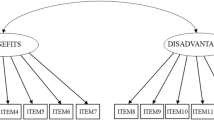Abstract
A survey design was used to elicit workers'perceptions of providing crisis outreach services tosurvivors of the 1993 flood in Illinois. Findingshighlight the benefits of recruiting local workers indisaster relief work. Positive outcomes of theexperience include both personal and professionalgrowth.
Similar content being viewed by others
REFERENCES
Ballew, R. (1985). Role of natural helpers in preventing child abuse and neglect. Social Work, 30,37–41.
Bradfield, C., Wylie, M., & Echterling, L. (1989). After the flood: The response of ministers to a natural disaster. Sociological Analysis, 49,397–407.
Collins, A., & Pancoast, D. (1976). Natural helping networks: A strategy for prevention.National Association of Social Work. Washington D.C.
DMHDD. (1995). Final Report, Project Recovery: Regular service grant— Crisis Counseling Program.(Department of Mental Health and Developmental Disabilities-997-DR Crisis).
Duckworth, D. (1991). Facilitating recovery from disaster-work experiences. British Journal of Guidance and Counselling, 19,13–22.
Dufka, C. (1988). The Mexico City earthquake disaster. Social Casework, 69,162–170.
Figley, C. (1984). Role of the Family: Both haven and headache. Role stressors and supports for emergency workers. DHHS Pub. No (ADM) 85-1408, National Institute of Mental Health, p. 84–94. Rockville, Maryland: Author.
Frans, D. (1993). A scale for measuring social worker empowerment. Research on Social Work Practice, 3, 312–328.
Golden, G. (1991). Volunteer counselors: An innovative, economic response to mental health service gaps. Social Work, 36,230–232.
Hetherington, K. (1995). Professionals and nonprofessional beyond the difference: The emergence of mutual compromise. International Journal of Mental Health, 24,59–69.
Hodgkinson, P., & Shepherd, M. (1994). Impact of disaster support work. Journal of Traumatic Stress, 7,587–600.
Karakashian, M. (1994). Countertransference issues in crisis work with natural disaster victims. Psychotherapy, 31,334–341.
Koeske, G., Koeske, R., & Mallinger, J. (1993). Perceptions of professional competence: Cross-disciplinary ratings of psychologists, social workers, and psychiatrists. American Journal of Orthopsychiatry, 63,45–55.
Linton, J. (1995). Acute stress management with public safety personnel: Opportunities for clinical training and pro bono community service. Professional Psychology Research and Practice, 26,566–573.
Milne, D., & Kennedy, S. (1993) The utility of consumer satisfaction data: A case study in organizational behavioral management. Behavioral and Coping Psychotherapy, 21,281–291.
Muzekari, L., Lonigan, C., Bond, F., & Hiers, T. (1991). In the eye of the beholder: CMHC reactions to disaster. Paper presented at the 99th annual convention of the American Psychological Association, San Francisco, CA. (ERIC Document Reproduction Service NO. ED 336 693).
Oberlander, L. (1990). Work satisfaction among community-based mental health service providers: The association between work environment and work satisfaction. Community Mental Health Journal, 26,517–533.
Phifer, J. (1990). Psychological distress and somatic symptoms after natural disaster: Differential vulnerability among older adults. Psychology and Aging, 5,412–420.
Sherer, M. (1995). Professionals & nonprofessional beyond the difference: The emergence of mutual compromise. International Journal of Mental Health, 24,59–69.
Summers, M., & Cowan, M. (1991). Mental health issues related to the development of a national response system. Military Medicine, 156,30–33.
Tumelty, D. (1990). Social work in the wake of disaster.London: Jessica Kingsly Publishers Ltd.
Velleman, R. (1992). The use of volunteer counselors in helping problem drinkers: Community work in action? Journal of Mental Health UK, 1,301–310.
Vicente, B., Vielma, M., Jenner, F., Mezzina, R., & Lliapas, I. (1993). Attitudes of professional mental health workers to psychiatry. The International Journal of Social Psychiatry, 39,131–141.
Ware, J., Snyder, M., Wright, W., & Davies, A. (1983). Defining and measuring patient satisfaction with medical care. Evaluation and Program Planning, 6,247–263.
Rights and permissions
About this article
Cite this article
Soliman, H.H., Lingle, S.E. & Raymond, A. Perceptions of Indigenous Workers Following Participation in a Disaster Relief Project. Community Ment Health J 34, 557–568 (1998). https://doi.org/10.1023/A:1018706900439
Issue Date:
DOI: https://doi.org/10.1023/A:1018706900439




